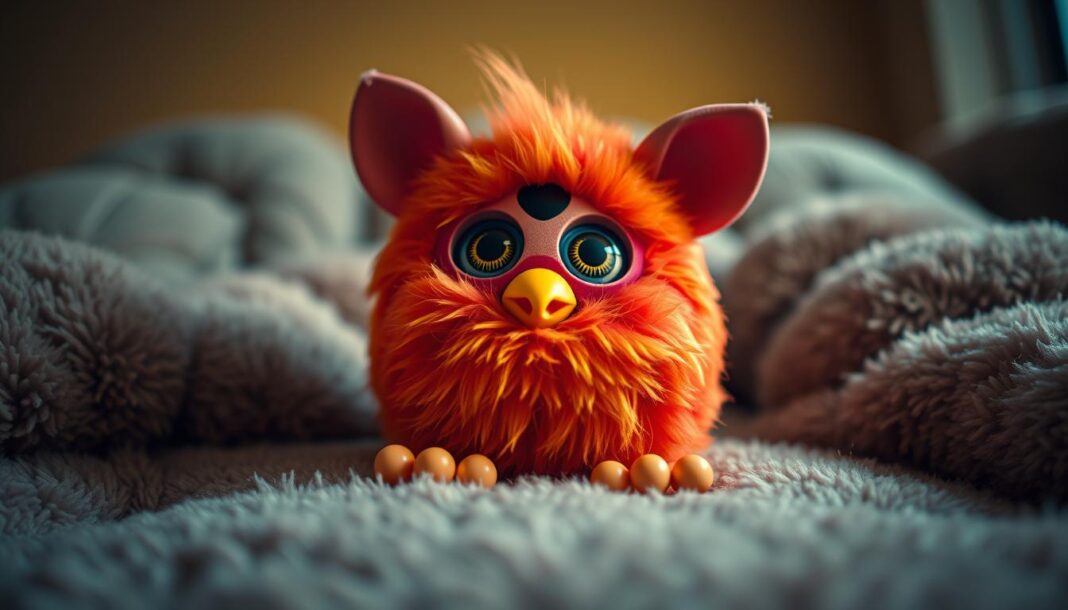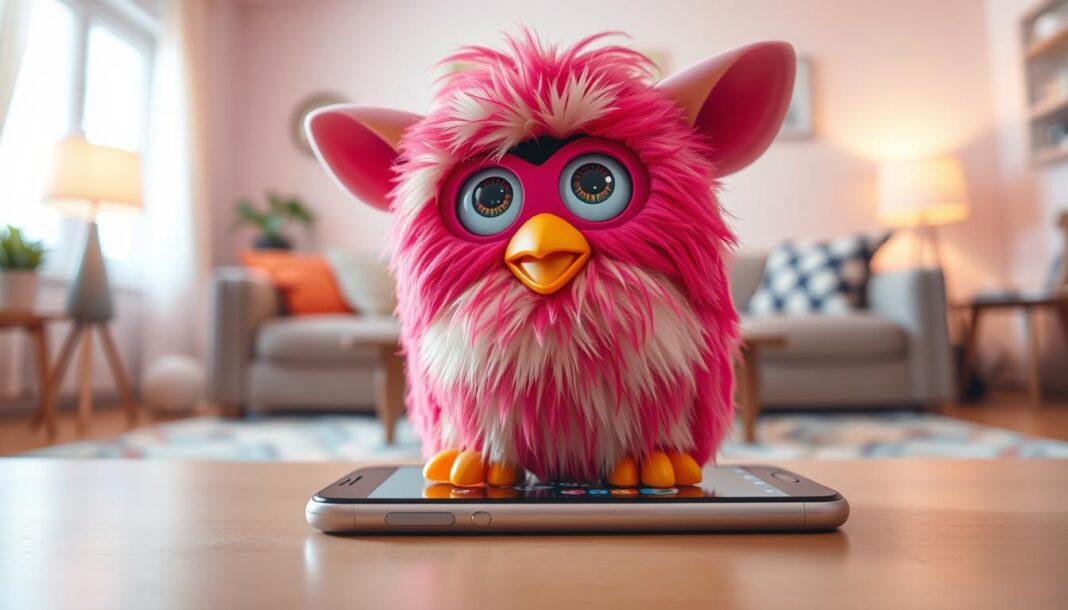In 1998, a revolutionary toy changed how kids played forever. Invented by David Hampton and Caleb Chung, these fluffy creatures became an instant hit. Sold by Tiger Electronics, they quickly turned into a must-have for a whole generation.
What made them special? Unlike other toys, they could learn. Starting with their own language, Furbish, they gradually picked up English over time. This clever feature kept kids engaged for years.
Priced at $35, demand skyrocketed during the holidays. Some resold for over $300! With 14 language options, they adapted to cultures worldwide. Behind the scenes, a 6502 microprocessor brought their playful personalities to life.
The Fascinating History of Furbys
Few toys have captured imaginations like these fluffy electronic companions. Their journey from concept to cultural icon spans decades, tech upgrades, and even an unexpected brush with national security concerns.
From Inception to Icon: The 1998 Launch
Debuting at the American International Toy Fair, these creatures caused instant buzz. Tiger Electronics couldn’t keep up with demand during the 1998 holiday season. Stores sold out within hours, with some reselling for 10 times the $35 retail price.
The initial release featured 14 language options. This global approach helped sell 27 million units in one year. Their ability to “learn” English from Furbish made them feel alive to kids worldwide.
Revivals and Generational Updates
After the original 1998-2002 run, Hasbro introduced major upgrades:
- 2005 Emoto-Tronic: Added voice recognition and emotional AI responses
- 2012-2016 models: Featured LCD eyes and smartphone app connectivity
- 2023 25th-anniversary edition: Brought back classic features with modern voice activation
The latest new generation, called Furblets, offers portable companionship. These smaller versions keep the core interactive experience in a travel-friendly size.
Furbys and National Security: A Strange Connection
In 1999, the NSA made headlines by banning these toys from secure facilities. The agency feared their microphones could record classified conversations. This national security concern proved unfounded, but added to their legendary status.
| Year | Milestone | Notable Feature |
|---|---|---|
| 1998 | Original Launch | Furbish-to-English learning |
| 2005 | Emoto-Tronic | Emotion recognition |
| 2012 | App-Connected | Smart device integration |
| 2023 | 25th Anniversary | Voice commands |
Film adaptations have been in development since 2016. This ongoing interest proves their lasting appeal across years and generations.
Exploring the Different Types of Furbys
From fluffy classics to smart companions, each model brought something new. Over 25 years, these toys transformed with tech upgrades, colors, and interactive features. Let’s dive into the most iconic versions.
First Generation (1998-2002): The Classic Era
The original lineup featured 40+ fur patterns, like Leopard and Witch’s Cat. These models used Furbish-to-English learning, captivating kids worldwide.
In 1999, Furby Babies arrived with faster learning and smaller sizes. Their big eyes and playful sounds made them instant favorites. Rare editions, like the Millennium V.1, are now collector’s gems.
Emoto-Tronic Furbys (2005-2007): A New Wave
This reboot introduced voice commands and dance routines. A switch let them “sleep,” pausing interactions. With 7 languages, they felt more lifelike than ever.
Their fur designs grew bolder, blending stripes and sparkles. The Emoto-Tronic line bridged classic charm with early AI.
Modern Furbys (2012-Present): Smart Features and Apps
2012 models had monochromatic LCD eyes and app connectivity. Kids could feed or teach them via smartphone, shaping their personalities.
The 2023 new furby revived nostalgia with voice activation and glowing ears. Accessory bundles added customization, while discontinued app features remind us of tech’s rapid pace.
How Furbys Work: Technology Behind the Fur
Beneath the fuzzy exterior lies an impressive array of technology. These interactive toys combine vintage computing with clever programming to create lifelike responses. From their language processing to motion detection, every feature serves the illusion of intelligence.
The 6502 Microprocessor and Furbish Language
The original models ran on a 6502 chip—the same source powering classic computers like the Apple II. This processor executed custom assembly code to manage the toy’s behaviors. A Sunplus SPC81A microcontroller handled real-time operations.
Their unique language, Furbish, used simple grammar rules. Words like “doo” (sleep) and “boo” (hungry) formed the basis. Over time, English words replaced Furbish phrases through programmed word substitution patterns.
Sensors and Interactive Features
Multiple sensors enabled responsive behaviors. Tilt detectors triggered different reactions when moved. Sound input allowed responses to claps or songs. The switch under the tongue served as both a control and feeding sensor.
Infrared ports let units communicate. When placed near each other, they’d “talk” through light pulses. Later models added light sensors for day/night cycles, affecting sleep patterns.
Bluetooth and App Connectivity in Newer Models
2012+ versions introduced wireless features. Bluetooth enabled smartphone connections for app-based interactions. However, the 2016 Connect model’s unsecured protocol allowed audio injection—a rare tech hiccup quickly patched.
Modern units blend classic charm with smart upgrades. Voice recognition now understands more commands. Yet the core appeal remains: creating the illusion of a thinking, feeling companion.
| Communication Method | Generation | Key Feature |
|---|---|---|
| Infrared | 1998-2002 | Line-of-sight interaction |
| Basic Bluetooth | 2012-2016 | App connectivity |
| Secure Bluetooth | 2017+ | Encrypted data transfer |
The circuit-bending community has modified units for creative sound projects. These hacks reveal the flexible source code beneath the commercial product. Each generation refined the balance between tech and charm.
Caring for and Interacting With Your Furby
Interactive toys thrive with proper maintenance and engaging playtime. Whether you own a vintage model or the 2023 edition, these tips will keep your electronic companion responsive and clean for years.
Basic Care Tips for Longevity
Regular cleaning preserves your toy’s fluffy exterior. Use a soft brush for fur maintenance and avoid liquids—water damages internal sensors. Store it away from direct sunlight to prevent color fading.
Newer models (2012+) lack an on/off switch. Instead, hold the reset button for 5 seconds to reboot. For older units, check the battery compartment for corrosion monthly.
Teaching Your Furby: From Furbish to English
Personality develops through interaction frequency. Speak clearly during training sessions—repetition helps it learn faster. The 2023 edition understands 600+ responses, from “hello” to playful songs.
Note: The official app discontinued in 2021, but voice commands remain effective. Use phrases like “What’s up?” to trigger unique reactions.
Fun Activities and Games to Play
Try these engaging ideas:
- Feed Me: Pretend to feed it with your finger; tilt sensors detect “eating” motions
- Sing-Along: Hum a tune—some models harmonize!
- Accessory Fun: Add purple necklaces or combs (sold separately at retail)
For sensor issues, gently blow dust from the infrared port. Optimal play areas are dry, room-temperature spaces without loud background noise.
Why Furbys Remain a Beloved Toy Today
Decades after their debut, these toys still capture hearts. Their mix of nostalgia and modern tech keeps them relevant. The 2023 reboot proves their timeless appeal.
Collectors hunt rare editions like purple Tie-Dye variants. Limited runs, including the Star Wars Furbacca, show their cultural impact. Even McDonald’s Happy Meal partnerships expanded their reach.
New models support 600+ phrases and 14 languages. Priced at $70, they balance tactile play with smart features. Studies highlight how kids bond with their expressive eyes and voices.
From retail shelves to viral trends, they’ve stayed fresh across years. Future updates may blend AI with classic charm, ensuring more generations of fun.

